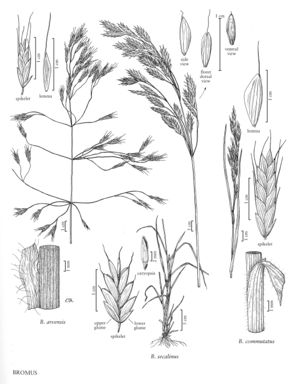Difference between revisions of "Bromus arvensis"
FNA>Volume Importer |
imported>Volume Importer |
||
| (2 intermediate revisions by the same user not shown) | |||
| Line 4: | Line 4: | ||
|publications= | |publications= | ||
|common_names=Field brome | |common_names=Field brome | ||
| + | |special_status={{Treatment/ID/Special_status | ||
| + | |code=I | ||
| + | |label=Introduced | ||
| + | }} | ||
|basionyms= | |basionyms= | ||
|synonyms= | |synonyms= | ||
| Line 16: | Line 20: | ||
-->{{Treatment/Body | -->{{Treatment/Body | ||
| − | |distribution=Conn.;N.J.;N.Y.;Wash.;Del.;D.C;Wis.;W.Va.;Mass.;Maine;N.H.;R.I.;Vt.;Fla.;Wyo.;N.Mex.;Tex.;La.;Tenn.;N.C.;S.C.;Pa.;Nev.;Va.;Colo.;Md.;Calif.;Ala.;Kans.;N.Dak.;Nebr.;Okla.;S.Dak.;Miss.;Ark.;Ill.;Ga.;Ind.;Iowa;Ariz.;Idaho;Alta.;B.C.;Man.;Ont.;Que.;Sask.;Mont.;Oreg.;Ohio;Utah;Mo.;Minn.;Mich.;Ky. | + | |distribution=Conn.;N.J.;N.Y.;Wash.;Del.;D.C.;Wis.;W.Va.;Mass.;Maine;N.H.;R.I.;Vt.;Fla.;Wyo.;N.Mex.;Tex.;La.;Tenn.;N.C.;S.C.;Pa.;Nev.;Va.;Colo.;Md.;Calif.;Ala.;Kans.;N.Dak.;Nebr.;Okla.;S.Dak.;Miss.;Ark.;Ill.;Ga.;Ind.;Iowa;Ariz.;Idaho;Alta.;B.C.;Man.;Ont.;Que.;Sask.;Mont.;Oreg.;Ohio;Utah;Mo.;Minn.;Mich.;Ky. |
|discussion=<p><i>Bromus arvensis</i> grows along roadsides and in fields and waste places at scattered locations in the Flora region. It is native to southern and south-central Europe.</p> | |discussion=<p><i>Bromus arvensis</i> grows along roadsides and in fields and waste places at scattered locations in the Flora region. It is native to southern and south-central Europe.</p> | ||
|tables= | |tables= | ||
| Line 34: | Line 38: | ||
|illustrator=Cindy Roché | |illustrator=Cindy Roché | ||
|illustration copyright=Utah State University | |illustration copyright=Utah State University | ||
| − | |distribution=Conn.;N.J.;N.Y.;Wash.;Del.;D.C;Wis.;W.Va.;Mass.;Maine;N.H.;R.I.;Vt.;Fla.;Wyo.;N.Mex.;Tex.;La.;Tenn.;N.C.;S.C.;Pa.;Nev.;Va.;Colo.;Md.;Calif.;Ala.;Kans.;N.Dak.;Nebr.;Okla.;S.Dak.;Miss.;Ark.;Ill.;Ga.;Ind.;Iowa;Ariz.;Idaho;Alta.;B.C.;Man.;Ont.;Que.;Sask.;Mont.;Oreg.;Ohio;Utah;Mo.;Minn.;Mich.;Ky. | + | |distribution=Conn.;N.J.;N.Y.;Wash.;Del.;D.C.;Wis.;W.Va.;Mass.;Maine;N.H.;R.I.;Vt.;Fla.;Wyo.;N.Mex.;Tex.;La.;Tenn.;N.C.;S.C.;Pa.;Nev.;Va.;Colo.;Md.;Calif.;Ala.;Kans.;N.Dak.;Nebr.;Okla.;S.Dak.;Miss.;Ark.;Ill.;Ga.;Ind.;Iowa;Ariz.;Idaho;Alta.;B.C.;Man.;Ont.;Que.;Sask.;Mont.;Oreg.;Ohio;Utah;Mo.;Minn.;Mich.;Ky. |
|reference=None | |reference=None | ||
|publication title= | |publication title= | ||
|publication year= | |publication year= | ||
| − | |special status= | + | |special status=Introduced |
| − | |source xml=https:// | + | |source xml=https://bitbucket.org/aafc-mbb/fna-data-curation/src/200273ad09963decb8fc72550212de541d86569d/coarse_grained_fna_xml/V24/V24_323.xml |
|subfamily=Poaceae subfam. Pooideae | |subfamily=Poaceae subfam. Pooideae | ||
|tribe=Poaceae tribe Bromeae | |tribe=Poaceae tribe Bromeae | ||
Latest revision as of 16:23, 11 May 2021
Plants annual. Culms 80-110 cm, erect. Lower sheaths with dense, soft, appressed hairs; ligules 1-1.5 mm, hairy, obtuse, erose; blades 10-20 cm long, 2-6 mm wide, coarsely pilose on both surfaces. Panicles 11-30 cm long, 4-20 cm wide, open, erect or nodding; branches usually longer than the spikelets, ascending to widely spreading, slender, slightly curved or straight. Spikelets 10-25 mm, lanceolate, terete to moderately laterally compressed, often purple-tinged; florets 4-10, bases concealed or visible at maturity; rachilla internodes concealed or visible at maturity. Glumes glabrous; lower glumes 4-6 mm, 3-veined; upper glumes 5-8 mm, 5-veined; lemmas 7-9 mm long, 1.1-1.5 mm wide, lanceolate, obscurely 7-veined, rounded over the midvein, glabrous, coriaceous, margins slightly angled, inrolled or not at maturity, apices acute, bifid, teeth shorter than 1 mm; awns 6-11 mm, straight, arising at varying distances below the lemma apices; anthers 2.5-5 mm. Caryopses shorter than the paleas, weakly to strongly inrolled. 2n = 14.
Distribution
Conn., N.J., N.Y., Wash., Del., D.C., Wis., W.Va., Mass., Maine, N.H., R.I., Vt., Fla., Wyo., N.Mex., Tex., La., Tenn., N.C., S.C., Pa., Nev., Va., Colo., Md., Calif., Ala., Kans., N.Dak., Nebr., Okla., S.Dak., Miss., Ark., Ill., Ga., Ind., Iowa, Ariz., Idaho, Alta., B.C., Man., Ont., Que., Sask., Mont., Oreg., Ohio, Utah, Mo., Minn., Mich., Ky.
Discussion
Bromus arvensis grows along roadsides and in fields and waste places at scattered locations in the Flora region. It is native to southern and south-central Europe.
Selected References
None.
